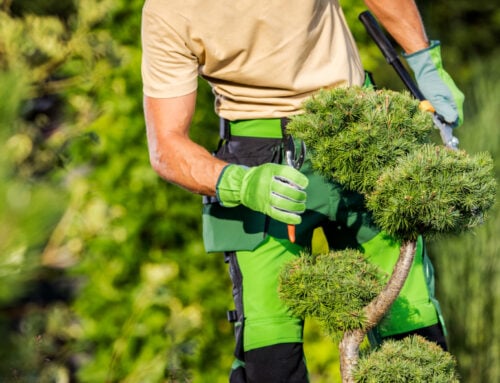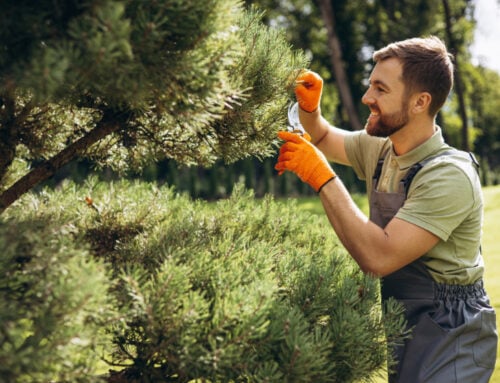Pine trees, with their distinct structure and rich green foliage, are a striking addition to any landscape. They create a sense of tranquility and evoke images of serene woodland areas. However, landscaping with pine trees requires a keen understanding of their specific needs and growth patterns. We will help you unlock the potential of these majestic trees, guiding you through the entire process, from selection and planting to long-term maintenance and care.
Pine Tree Varieties
There are over 100 species of pine trees, each with its unique characteristics, making them adaptable to a variety of landscaping needs and styles. Some popular varieties include the Eastern White Pine, known for its delicate, feathery needles and fast growth rate. The Ponderosa Pine, a western North American native, is cherished for its tall, straight trunk and iconic pine scent. The Scotch Pine stands out with its twisted, bluish-green needles and textured bark. The Mugo Pine, a dwarf variety, contributes wonderfully to rock gardens and small yards. Understanding the characteristics, growth patterns, and maintenance needs of different pine tree varieties will help you choose the best fit for your landscaping aspirations.
Design Principles
Designing with pine trees necessitates a deliberate approach that takes into consideration their size, form, and growth patterns. Here are some key principles to follow. Firstly, consider the scale of your landscape. Larger species like Ponderosa Pine make a grand statement in spacious landscapes but can overwhelm smaller spaces. Dwarf varieties like Mugo Pine, on the other hand, are perfect for smaller yards or rock gardens. Secondly, think about the tree’s form and how it will integrate with the overall design.
For instance, the straight, tall trunk of a Ponderosa Pine can provide a dramatic vertical element, while the twisted needles of a Scotch Pine can create interesting textures. Lastly, consider the growth rate and maintenance needs of the tree. Faster-growing species may provide a quicker result but can also require more upkeep.
Seasonal Aesthetics
One of the many charms of pine trees is their year-round beauty. Unlike deciduous trees, pines hold onto their needles throughout all seasons, providing a constant splash of green even in the heart of winter. In spring, new growth can give the trees a vibrant, lush appearance, while in the autumn, pine cones mature, adding another layer of visual interest.
Some varieties, like the Eastern White Pine, can even take on a slight silvery appearance in certain light conditions, creating a fascinating spectacle. However, the seasonal aesthetics of pine trees don’t stop at their visual appeal. The scent of pine is most potent during the warm summer months, providing a sensory delight that enhances the overall ambiance of your outdoor space.
Environmental Considerations
When selecting pine trees for your landscape, it’s crucial to consider the environment in which they will be planted. Pine trees are generally resilient and adaptable, but every species has its own set of environmental preferences. For instance, the Ponderosa Pine thrives in dry, sunny climates and well-drained soils, while the Eastern White Pine prefers cooler, more humid climates and acidic soil. It’s also essential to consider the tree’s water needs and tolerance to pollution or salt.
Artistic Elements
The artistic elements of landscaping with pine trees center around their unique shapes, textures, and colors. Their conical form creates a strong visual structure, adding depth and dimension to the landscape. The diverse needle colors, ranging from bright green to bluish or silvery tones, offer an intriguing palette to play with. Additionally, the rugged, textured bark of species like the Scotch Pine adds visual intrigue.
The varying sizes and forms of pine cones, whether hanging from the branches or scattered on the ground, provide natural decorations. Integrating other landscape elements such as rocks, water features, or complementary plants can further enhance the artistic appeal of your pine tree landscape.
Maintenance Tips
Maintaining your pine tree landscape involves a combination of regular care and timely interventions to ensure the health and longevity of the trees. Firstly, watering should be done effectively, focusing on deep watering to promote deep root growth, though the frequency will depend on the species and the local climate.
Secondly, mulching around the base of the trees will help to retain soil moisture and regulate temperature. It also adds an aesthetic touch to your landscape. Next, pruning is essential to maintain the shape, remove dead or diseased branches, and control the size of the tree.
Lighting and Shadows
The play of lighting and shadows can dramatically enhance the beauty of your pine tree landscape. The strong, distinctive shapes of pine trees make them ideal subjects for creating intriguing shadow patterns. During the day, the sun casts evolving shadows that add depth and mystery to your landscape.
The changing angles of light throughout the day and across seasons can illuminate your pines in stunning ways, highlighting their textures and colors. In addition to natural light, consider adding outdoor lighting fixtures for nighttime. Strategically placed lights can showcase the trees’ silhouettes, create dramatic shadows, and provide a captivating focal point in the dark.
Integrating Pine Trees with Other Plants
When integrating pine trees with other plants in your landscape, it’s important to consider both aesthetic and ecological aspects. Choose companion plants that complement the visual properties of the pines – their height, color, and texture. Ferns, rhododendrons, and hostas are good options as they thrive in the acidic soil conditions often found under pines.
Additionally, ground-cover plants like vinca or sweet woodruff can add a lush, green carpet beneath your pine trees. Incorporate spring-flowering bulbs such as daffodils or crocuses to create seasonal interest
Why You Need a Professional Arborist
Employing the services of a professional arborist can significantly benefit the health and aesthetics of your landscape. An arborist, being a specialist in the care of individual trees, is equipped with the knowledge and equipment to effectively care for your pines. They are trained to understand the needs of trees and provide the necessary care. Regular inspection by an arborist can help detect potential diseases or pest infestations early and apply appropriate treatments, therefore preventing significant damage.
LTRC Tree Specialists in Alpharetta, Georgia
Are you ready to transform your landscape into a pine tree paradise or require expert care for your existing pine trees? Don’t hesitate to contact LTRC Tree Specialists. Located in Alpharetta, Georgia, we’re just a call away. Reach out to us at (404) 288-5872, and allow our team of professional arborists to provide you with top-notch tree care services. Your vibrant, healthy, and beautiful pine landscape is just a call away with LTRC Tree Specialists.

Contact Us For A Free Estimate!







